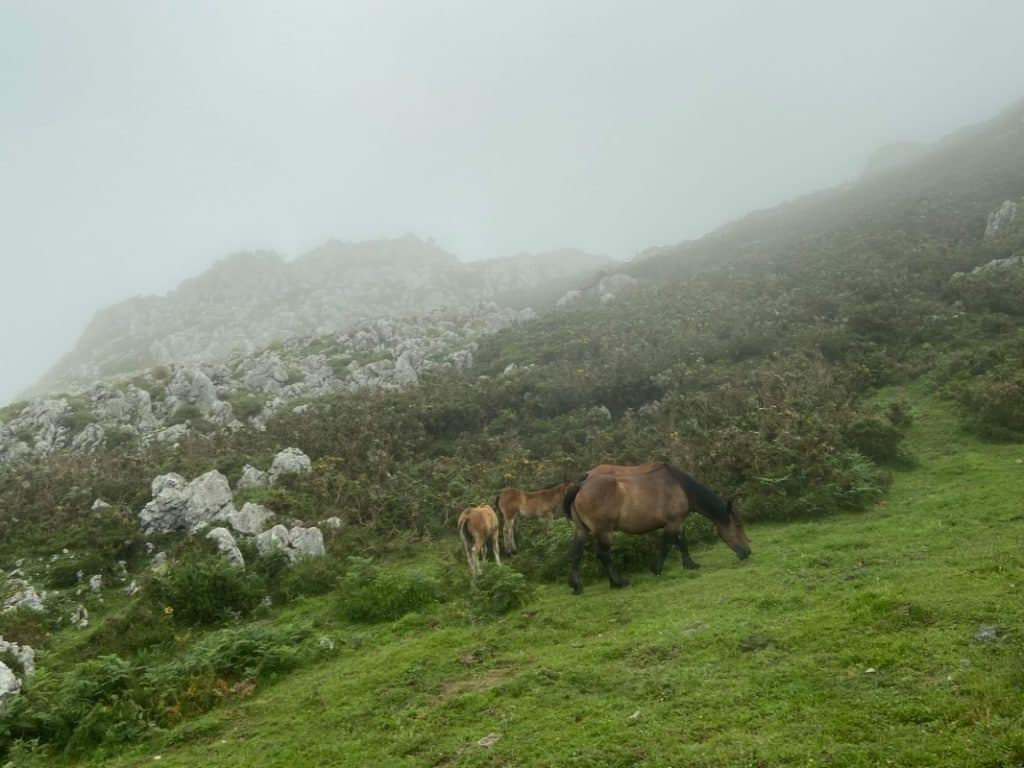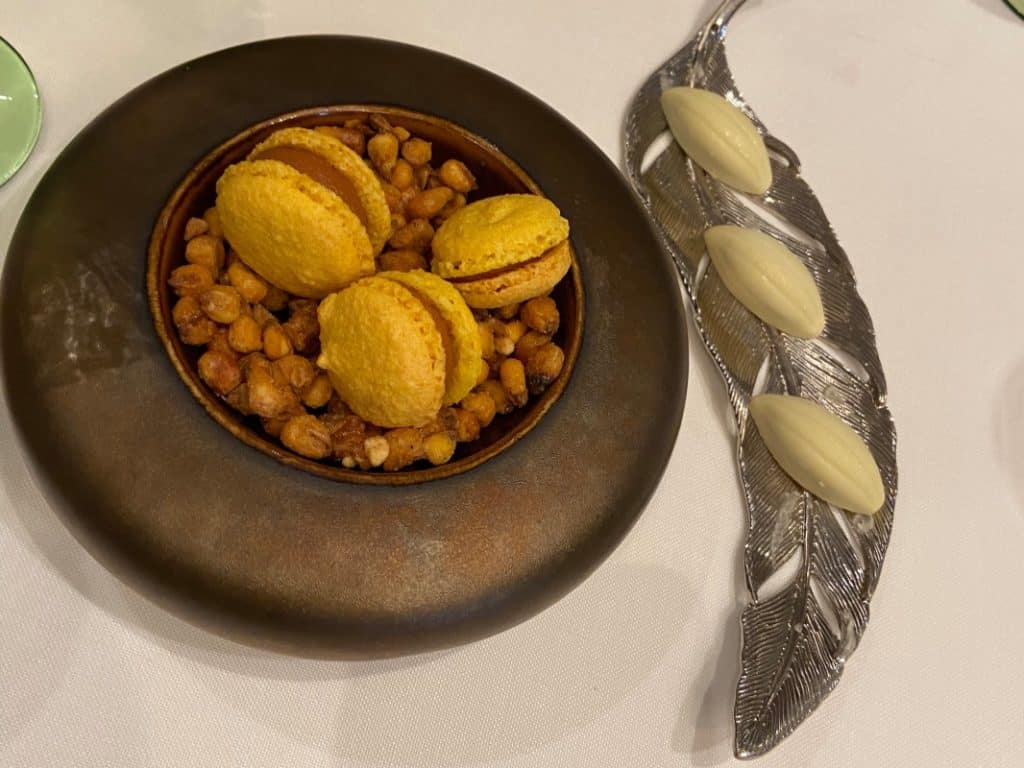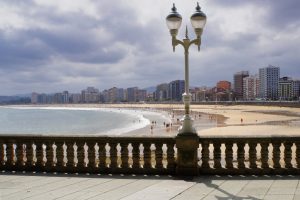We took the bus for an excursion to the Picos de Europa National Park. If the reports about the area are to be believed, it is one of the most beautiful landscapes in the region. So much for the theory…….
The Picos de Europa National Park begins just 15 kilometers from the Cantabrian coast. The second largest Spanish national park extends across Asturias, Castilla y León and Cantabria.
The first national park in Spain, Covadonga National Park, was created in 1918. It is located on the western side of the Picos de Europa mountain range. Later (from 1995), the area was extended to include other areas, including the Central and Eastern Massifs. The Picos de Europa National Park was created.

The mountain massif consists of limestone. The strong karstification has led to interesting geological structures, which are reflected, for example, in the many caves, some of which are very deep.
The flora and fauna in the national park are particularly beautiful. Deciduous forests with various types of oak, ash, sweet chestnut and elm dominate up to an altitude of around 500 meters. At higher altitudes, you are more likely to find beech, holly, hazel or bog birch. From around 1600 meters, as is usual in the high mountains, there are no more trees, only grasses and shrubs. Here, hikers will mainly find dwarf juniper. Above 2200 meters there are no more shrubs.

If you are lucky on your exploration tours through the national park, you will mainly see Pyrenean chamois, red deer, foxes and wild boar. There are also populations of European wildcats, wolves and the occasional brown bear roaming the mountains. For bird lovers, it is worth taking a look at the sky. Various eagles, vultures and other mountain birds make their home in the national park. I only saw horses during my visit.
More detailed information is available at the visitor centers, which are open all year round. These are located in Buferrera/Lagos de Covadonga (Pedro Pidal), Cangas de Onís (Casa Dago) and Posada de Valdeón (Oficina de Valdeón).
How do I get to the Picos de Europa National Park?
To the east of the national park is the N-621 highway, which runs from Unquera in Cantabria to Riaño in León. To the west, the N-625 connects Riaño with Cangas de Onis, which is located to the northwest of the national park. The AS-114 runs north of the national park and provides a connection between Cangas de Onis and Panes. There are also regular bus services from Oviedo and Santander to the national park itself and the surrounding villages.

The high altitudes of the Picos de Europa are easily accessible for visitors, either via the cable car from Fuente Dé or the funicular from Bulnes. Hikers also have the opportunity to find accommodation in ten different mountain huts and experience the beauty of the national park up close.
Trip to the Picos de Europa National Park
The drive took us to the Pedro Pidal visitor center. The road slowly wound its way uphill and I have to admit that I was amazed at how much traffic there is in a national park. Sometimes the bus driver had to maneuver, and if another bus came towards him, the road could become very narrow.
At first, I found the path quite uninteresting – there were stones, trees and cars to see. That changed abruptly when the forest was replaced by large meadows. There were cows grazing everywhere, shepherds driving groups of goats and you could already guess how mighty the mountain range would be.
It became particularly exciting when the cows were no longer standing in the meadows, but the grass on the side of the road seemed to taste much better.

There wasn’t just one cow walking along the road and not being disturbed by the cars. I rather had the feeling that they enjoyed blocking the traffic and thus drew attention to the disturbance in their habitat. In any case, we had to wait several times for the spotted friends to make way for us. A wonderful spectacle!

I didn’t notice that it was getting foggier and foggier during the whole cow TV. The clouds hung low in the valley and obscured everything around us. When we finally stopped at the visitor center you couldn’t see anything. So nothing is actually wrong, you could see clouds and about 50 meters of a path leading to nowhere.

It was announced that a 15-minute stay was planned here. If the weather had been great, I would certainly have been annoyed that the time was so short. The view must be simply magnificent. But as it was, I used the time to walk to the viewing platform and see nothing.
Back at the bus, we were just starting to get on when the sun won the battle against the clouds. Visibility suddenly improved and so the bus had to wait until we had taken some photos.

Lagos de Covadonga
The bus ride now took us back the way we had just come. The cows had withdrawn from the road and so we made faster progress.
Yes, and then we drove past a beautiful glacial lake that we hadn’t been able to see on the outward journey due to the fog. In this part of the national park are the glacial lakes Enol and Ercina, the third small lake El Bricial is only filled with water when the snow melts.

Cows grazed around the lake and the mighty mountain massif rose into the air. There are even signposted hiking trails around the lakes. One more item on my “must visit again” list.
What I didn’t know: In cycling, the road is one of the most famous climbs of the Vuelta a España, with a climb of 200m to 1110m up to the Lagos de Covadonga. The gradient here is 13% in places.
Covadonga
Our next stop was in Covadonga. A tiny village that is one of the most famous stops on the Way of St. James to Santiago de Compostela.
Around 60 inhabitants live here in the middle of the Picos de Europa mountains and hundreds of tourists come every day to pray in the church and the rock cave.
If you look back at the history of the Marian shrine in the rock cave, you will find that it dates back to the time of the Visigoths. The Battle of Covadonga took place there in 722, in which the Christians defeated the Muslims. This date is considered the beginning of the Reconquista in northern Spain. Allegedly, the intervention of a heavenly power led to the protection of the sanctuary. This support came from a virgin who caught the arrows of the hated Moorish invaders and hurled them back at the enemy with deadly force. Since that time, the Congadova has been a place of pilgrimage to the Virgin Mary.

Today, there is a belief that young unmarried women will soon get married after drinking from the Fuente del Matrimonio, which is open to the public there.
Basilica von Covadonga
In 1901, the Pope of the time granted the church in the small village its status as a basilica. It was built as a “supplement” for visitors to the cave with the Virgin of Covadonga.

I reach the neo-Romanesque building via a wide path. I find the coloring particularly beautiful, especially when the sun is shining. Then the pink sandstone glows beautifully.
In the towers there is a clock whose carillon plays the hymn of Covadonga: “Blessed is the queen of our mountains, whose throne is the cradle of Spain…”. If you’re lucky, you’ll be there at just the right time to listen to the carillon. Unfortunately, I didn’t hear it.

Photography is prohibited inside the church. Clergymen walk around the nave and keep a close eye. I was amazed at how simply the church is designed. There are only a few decorative elements and so the chancel attracts all the attention. It is dominated by a seated figure of the Virgin and Child and two large paintings. These depict the Battle of Covadonga and the proclamation of Pelayo as king.
Cave with the “Virgin of Covadonga” and the bones of King Pelayo
The first expansion of the cave dates back to the time of Alfonso I, who ordered the construction of a chapel to commemorate King Pelayo’s victory over the Muslims. The cave was lined with wood. Unfortunately, a fire (1777) destroyed the sanctuary with its valuable carvings. A new carving of the Virgin was erected in 1778.
The tomb of King Pelayo and his wife is also located in the cave. The bodies were transferred to Covadonga by order of King Alfonso X to give the place even greater significance.
The cave is reached via a long corridor. Many candles, placed by the faithful during a silent prayer, stand at the entrance. The candles, I observed, were bought beforehand from a vending machine that looked almost like a drinks machine.

Photography is prohibited from a certain point on the way to the cave. Even though many visitors reacted to this with incomprehension, I think it’s a very good thing. Of course, I would also have liked to show a picture of the beautiful Santina holding a child and a golden rose. But it is a place of prayer, of contemplation – even if the visitors push past the figure in a long queue. However, if you have a good lens on your camera, you can certainly get a picture from the hill opposite.
I was amazed to see a priest standing right next to the small altar, blessing each visitor and praying incessantly. For someone who has asked for something there, it must have been a wonderful thing.
Restaurante El Corral del Indianu
If you want to eat really well, you can do so in the restaurant El Corral del Indianu, which has been awarded a Michelin star. The restaurant is not far from Covadonga.
The restaurant is very cozy and furnished with great attention to detail.

José Antonio Campoviejo is in charge of the kitchen and conjures up wonderful dishes.

During my visit, for example, the starter consisted of macarons with a savory filling and white chocolate pralines with a salty filling. For the main course, we enjoyed a typical dish from the Asturias region: a stew of white beans and black pudding.

I really enjoyed the food and, combined with the wonderful atmosphere there, it was an all-round successful stay.
Adresse:
Av. de Europa, 14,
33540 Arriondas, Asturias, Spanien
The visit to the Picos de Europa National Park and the subsequent program points took place during the trip on the Costa Verde Express .








Leave a Reply